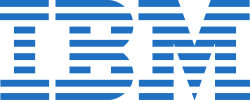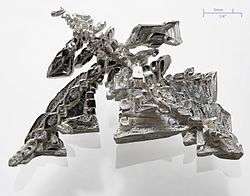IBM 3090
The IBM 3090 family was a high-end successor to the IBM System/370 series, and thus indirectly the successor to the IBM System/360 launched 25 years earlier.[1][2]
 | |
| Manufacturer | International Business Machines Corporation (IBM) |
|---|---|
| Product family | Models 120E, 150, 150E, 180, 180E, 200, 200E, 300, 300E, 400, 400E, 600E, 600J, 600S |
| Predecessor | IBM 308X |
| Successor | IBM ES/9000 |
| Website | Official website IBM Archives |
Although the Feb. 12, 1985 initial announcement of the family's first two members, the Model 200 and Model 400, lacked explicit mention of both the name System/370 and the term backward compatibility, the aforementioned pair and the subsequently announced Models 120E,[3] 150, 150E, 180, 180E, 200, 200E, 300, 300E, 400, 400E, 600E, 600J, and 600S[4] 3090 were described as using "ideas from the .. IBM 3033, extending them... It also took... from the .. IBM 308X."[5]
The 400 and 600 were respectively two 200s or 300s coupled together as one complex, and could run in either single-system image mode or partitioned into two systems.[4]
Models and features
| Model | Announced | N-way/processor(s) |
|---|---|---|
| 200 | 1985 | 2 central processors |
| 400 | 1985 | 4-way (two 200s) |
| 120E | Uniprocessor | |
| 150 | Uniprocessor | |
| 150E | Uniprocessor | |
| 180 | Uniprocessor | |
| 300 | 1987 | 3-way (triadic) |
| 600E | 1987 | 6-way (two 300s) |
| 600S | 1988 | 6-way (two 300s) |
| 600J | 1989[6] | 6-way (two 300s) |
Cooling
By the late 1970s and early 1980s, patented technology allowed Amdahl mainframes of this era to be completely air-cooled, unlike IBM systems that required chilled water and its supporting infrastructure.[7] The eight largest of the 18 models of the ES/9000 systems introduced in 1990 were water-cooled; the other ten were air-cooled.[8]
Remote service capabilities
A modem for "remote service capabilities" was standard; IBM recommended their IBM 3864 model 2.[9][10]
Vector facility
In October 1985, IBM introduced an optional vector facility[11] for the IBM 3090; such a facility had not been previously available in the System/370 architecture, thus bringing integrated supercomputer capabilities to the mainframe line. IBM entered into partnerships with several universities to promote the use of the 3090 in scientific applications, and efforts were made to convert code traditionally run on Cray computers.[12] Along with the vector unit, IBM introduced their Engineering and Scientific Subroutines Library and a facility to run programs written for the discontinued 3838 array processor.[13]
Photos


See also
References
- "IBM Archives: 3090 Processor Complex". www-03.ibm.com. 23 January 2003.
- Tucker, S. G. (1986). "The IBM 3090 system: An overview". IBM Systems Journal. 25 (1): 4–19. doi:10.1147/sj.251.0004. ISSN 0018-8670.
- "IBM 3090 PROCESSOR UNIT MODEL 120E, IBM 3092 PROCESSOR CONTROLLER MODEL 3". www-01.ibm.com. 19 May 1987.
- "IBM 3090 Processor Complex: Planning and Installation Reference (GG66-3090-1)" (PDF).
- http://www.chilton-computing.org.uk/ccd/mainframes/p001.htm
- IBM Announcement 189-176 Oct 24,1989
- Giants of Computing: A Compendium of Select, Pivotal Pioneers, by Gerard O’Regan (2013), ISBN 1447153405. "IBM's machines were water-cooled, while Amdahl's were air-cooled"
- http://www-03.ibm.com/ibm/history/exhibits/mainframe/mainframe_FS9000.html
- https://www.pinterest.com/pin/24418022954032714 - identified 2017 as a "vintage" modem
- ed-thelen.org/comp-hist/IBM-ProdAnn/3863.pdf "IBM 3864 is a 4800 bps synchronous modem. They are offered in two models: .. in point-to-point or multipoint mode
- IBM Corporation (August 1986). IBM System/370 Vector Operations (PDF). Retrieved Sep 20, 2018.
- Kent, Allen; Williams, James G., eds. (1994). "Supercomputing in Education and Research". Encyclopedia of Computer Science and Technology. 30. CRC Press. p. 319.
In October 1985, IBM introduced a vector feature to its high-end processor family, the IBM 3090.
- Connolly, James (1985-10-07). "Vector processor takes aim at mid-range mart". Computerworld. p. 1. Retrieved 2016-03-31.
- The sign on the left says IBM
Further reading
- Prasad, N.S. (1989). IBM Mainframes: Architecture and Design. McGraw-Hill. ISBN 0070506868. — Chapter 10 (pp. 255–268) describes the 3090.